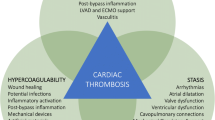Abstract
Life-threatening intracardiac and great vessels thrombi are rare in neonates. Recombinant tissue plasminogen activator (rTPA) is used in adults to stimulate fibrinolysis and facilitate thrombus resolution. Its use in neonates, along with heparin, remains controversial because of potential risk of serious bleeding. We aim to present our experience with the use of thrombolytic agents in seven neonates and young infants. In a retrospective study, over a period of 6 years, the medical records of neonates and young infants, who were diagnosed with intracardiac and great vessels thrombi, were reviewed. The following factors were collected: demographic data, primary diagnosis, thrombus site, risk factors, method of diagnosis, thrombolytic and/or anticoagulation agent, route, dose and duration of treatment, complications, and outcome. Six neonates and one 45-day-old infant were analyzed. Age ranged from 5 to 45 days (median age 12 days), and median weight was 2.9 kg (range 0.9–3.8 kg). The thrombi were diagnosed by echocardiography in five and by angiography in two cases. All patients had life-threatening thrombi; four were treated with rTPA (0.5 mg kg−1 h−1) and heparin infusions with complete dissolution of the thrombi, within a median time of 60 h (6–72 h), and without complications. The remaining three patients (two who were premature, at 28 and 34 weeks of gestation, and the third who had a deranged coagulation profile) were treated with unfractionated heparin due to fear of bleeding. The thrombi dissolved in the premature babies (within 2 weeks and 3 months, respectively) but embolized and resulted in the death of the third infant after 2 weeks of treatment. The current case series confirmed the effectiveness and safety of intravenous rTPA infusion, at the dosages used, in neonates and young infants with life-threatening thrombi.



Similar content being viewed by others
References
Andrew M, Brooker L, Leaker M, Paes B, Weitz J (1992) Fibrin clot lysis by thrombolytic agents is impaired in newborns due to low plasminogen concentration. Thromb Haemost 68(3):325–330
Barkhausen J, Hunold P, Eggebrecht H, Schuler WO, Sabin GV, Erbel R et al (2002) Detection and characterization of intracardiac thrombi on RM imaging. Am J Roentgenol 179:1539–1544
Chaikof EL, Dodson TF, Salam AA, Lumsden AB, Smith RB (1992) Acute arterial thrombosis in the very young. J Vasc Surg 16:428–435
De Castro S, Magni G, Beni S et al (1997) Role of transthoracic and transesophageal echocardiography in predicting embolic events in patients with active infective endocarditis involving native cardiac valves. Am J Cardiol 80:1030
El-Segaier M, Galal MO, Shiekh Eldin G, Momenah T (2015) Recanalization of arterial duct is feasible, effective and its potential risks are treatable. Acta Cardiol 70(1):13–19
Gupta AA, Leaker M, Andrew M, Massicotte P, Liu L, Benson LN, McCrindle BW (2001) Safety and outcomes of thrombolysis with tissue plasminogen activator for treatment of intravascular thrombosis in children. J Pediatr 139(5):682–688
Hartmann J, Hussein A, Trowitzsch E et al (2001) Treatment of neonatal thrombus formation with recombinant tissue plasminogen activator: six years experience and review of the literature. Arch Dis Child Fetal Neonatal Ed 85(1):F18–F22
Khan MA, Momenah TS (2013) Percutaneous removal of right atrial thrombus by suction technique. Cardiol Young 1047:1–3. doi:10.1017/S951113002102
Lee SY, Baek JS, Kim GB, Kwon BS, Bae EJ, Noh CI, Choi JY, Lim HK, Kim WH, Lee JR, Kim YJ (2012) Clinical significance of thrombosis in an intracardiac blind pouch after a Fontan operation. Pediatr Cardiol 33(1):42–48
Marder VJ, Sherry S (1988) Thrombolytic therapy: current status. N Engl J Med 318:1585–1595
Massicotte P, Adams M, Marzinotto V, Brooker LA, Andrew M (1995) Low molecular weight heparin in pediatric patients with thrombotic disease: a dose finding study. J Pediatrics 128(3):313–318
Monagle P, Chan AK, Goldenberg NA, Ichord RN, Journeycake JM, Nowak-Göttl U, Vesely SK, American College of Chest Physicians (2012) Antithrombotic therapy in neonates and children: antithrombotic therapy and prevention of thrombosis, 9th edn: American College of Chest Physicians evidence-based clinical practice guidelines. Chest 141:11–2308
Monagle P, Chan AK, Goldenberg NA, Ichord RN, Journeycake JM, Gottle UA (2012) Antithrombotic therapy in neonates and children. Chest 141(2):e737
Newall F, Browne M, Savoia H et al (2007) Assessing the outcome of systemic tissue plasminogen activator for the management of venous and arterial thrombosis in paediatrics. J Pediatr Hematol Oncol 29:269–273
Nowak GU, Auberger K, Halimeh S, Junker R, Klinge J, Kreuz WD (1999) Thrombolysis in newborns and infants. Thromb Haemost 82:112–116
Paut O, Kreitmann B, Silicani MA et al (1992) Successful treatment of fungal right atrial thrombosis complicating central venous catheterization in a critically ill child. J Int Care Med 18(6):375–376
Ries M, Singer H, Hofbeck M (2012) Thrombolysis of a modified Blalock–Taussig shunt with recombinant tissue plasminogen activator in a newborn infant with pulmonary atresia and ventricular septal defect. Pediatr Cardiol 33(1):42–48
Van Rooden CJ, Molhoek SG, Rosendaal FR, Schalij MJ, Meinders AE, Huisman MV (2004) Incidence and risk factors of early venous thrombosis associated with permanent pacemaker leads. J Cardiovasc Electrophysiol 15:1258–1262
Wang M, Hays T, Balasa V et al (2003) Low dose tissue plasminogen activator thrombolysis in children. J Pediatr Hematol Oncol 25(5):379–385
William MD (2010) Thrombolysis in children. Br J Hematol 148(1):26–36
Acknowledgments
We acknowledge Ms. Penelope Swift BSN, RM, RGN, RSCN, Nurse Manager, Comprehensive Cancer Centre, King Fahad Medical City. Ms. Swift is a native English speaker who assisted us with language editing and correction.
Conflict of interest
None.
Ethical standard
Ethical clearance and permission to publish the related clinical information was obtained from the Hospital’s Institutional Review Board (IRB).
Author information
Authors and Affiliations
Corresponding author
Rights and permissions
About this article
Cite this article
El-Segaier, M., Khan, M.A., Khan, Z.U. et al. Recombinant Tissue Plasminogen Activator in the Treatment of Neonates with Intracardiac and Great Vessels Thrombosis. Pediatr Cardiol 36, 1582–1587 (2015). https://doi.org/10.1007/s00246-015-1199-0
Received:
Accepted:
Published:
Issue Date:
DOI: https://doi.org/10.1007/s00246-015-1199-0




